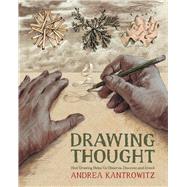
Drawing Thought How Drawing Helps Us Observe, Discover, and Invent
by Kantrowitz, AndreaBuy New
Rent Book
Used Book
We're Sorry
Sold Out
eBook
We're Sorry
Not Available
How Marketplace Works:
- This item is offered by an independent seller and not shipped from our warehouse
- Item details like edition and cover design may differ from our description; see seller's comments before ordering.
- Sellers much confirm and ship within two business days; otherwise, the order will be cancelled and refunded.
- Marketplace purchases cannot be returned to eCampus.com. Contact the seller directly for inquiries; if no response within two days, contact customer service.
- Additional shipping costs apply to Marketplace purchases. Review shipping costs at checkout.
Summary
Drawing is a way of constructing ideas and observations as much as it is a means of expressing them. When we are not ready or able to put our thoughts into words, we can sometimes put them down in arrangements of lines and marks. Artists, designers, architects, and others draw to generate, explore, and test perceptions and mental models. In Drawing Thought, artist-educator Andrea Kantrowitz invites readers to use drawing to extend and reflect on their own thought processes. She interweaves illuminating hand-drawn images with text, integrating recent findings in cognitive psychology and neuroscience with accounts of her own artistic and teaching practices.
The practice of drawing seems to be found across almost all known human cultures, with its past stretching back into the caves of prehistory. It takes advantage of the ways in which human cognition is embodied and situated in relationship to the environments in which we find ourselves. We become more aware of the interplay between our external surroundings and the inner workings of our minds as we draw. We can trace moments of perception and understanding in a sketchbook that might otherwise be lost, and go back to reexamine and revise those traces later. Kantrowitz encourages readers to draw out their own ideas and observations through a series of guided exercises and experiments, with her lively drawings and engaging text pointing the way. Drawing is a tool for thought in anyone’s hands; it is creativity in action.
Author Biography
Table of Contents
Prelude vii
Chapter 1: The Evolution of Thought 1
How to Take a Line for a Walk 16
Chapter 2: Below the Surface 19
How to Show Feelings 32
Chapter 3: The Thinking Hand 35
How to See Shapes 50
Chapter 4: Imaginary Friends 53
How to Overlap Shapes 68
Chapter 5: Drawn Together 71
How to Imagine a Place 86
Chapter 6: Thinking Space 89
How to Make Space 104
Chapter 7: A Tool of Thought 107
How to Take a Point of View 122
Chapter 8: Everybody Draw! 125
Notes: References, Research, and Suggestions for Further Reading 141
Acknowledgments 173
About the Author 177
An electronic version of this book is available through VitalSource.
This book is viewable on PC, Mac, iPhone, iPad, iPod Touch, and most smartphones.
By purchasing, you will be able to view this book online, as well as download it, for the chosen number of days.
Digital License
You are licensing a digital product for a set duration. Durations are set forth in the product description, with "Lifetime" typically meaning five (5) years of online access and permanent download to a supported device. All licenses are non-transferable.
More details can be found here.
A downloadable version of this book is available through the eCampus Reader or compatible Adobe readers.
Applications are available on iOS, Android, PC, Mac, and Windows Mobile platforms.
Please view the compatibility matrix prior to purchase.
